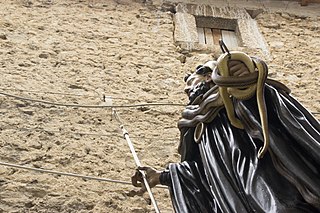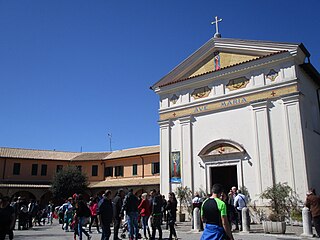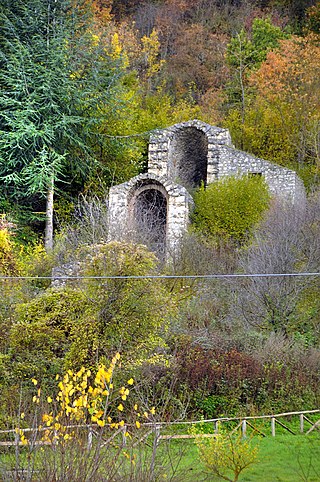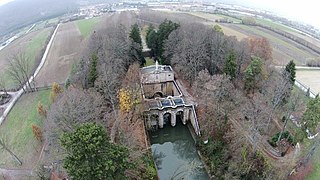
The Acropolis of Athens is an ancient citadel located on a rocky outcrop above the city of Athens, Greece, and contains the remains of several ancient buildings of great architectural and historical significance, the most famous being the Parthenon. The word Acropolis is from the Greek words ἄκρον and πόλις. The term acropolis is generic and there are many other acropoleis in Greece. During ancient times the Acropolis of Athens was also more properly known as Cecropia, after the legendary serpent-man Cecrops, the supposed first Athenian king.

Angitia was a goddess among the Marsi, the Paeligni and other Oscan-Umbrian peoples of central Italy. She was associated in antiquity with snake-charmers who claimed her as their ancestor. Roman interpretations probably obscure her Marsian significance.
The Marsi were an Italic people of ancient Italy, whose chief centre was Marruvium, on the eastern shore of Lake Fucinus. The area in which they lived is now called Marsica. They originally spoke a language now termed Marsian and attested by several inscriptions.

Alba Fucens was an ancient Italic town located at 1,000 m (3,300 ft) elevation at the base of Monte Velino, approximately 6.5 km (4.0 mi) north of Avezzano, Abruzzo, central Italy. Its ruins can be found in the comune of Massa d'Albe.

In ancient Roman religion, a lucus is a sacred grove.

Avezzano is a city and comune with a population of 40,881 inhabitants, situated in the Abruzzo region, province of L'Aquila, Italy. It is the second most populous municipality in the province and the sixth in the region. Avezzano was documented as an existing urban center in the ninth century. The city was destroyed by the earthquake of 1915. It was rebuilt after the 1944 Allied bombing. The city was decorated with the silver medal for civil merit, an award granted by the Italian Republic.

Lucus Feroniae was an ancient sanctuary or, literally sacred grove ("lucus"), dedicated to the Sabine goddess Feronia, protector of freedmen, ex-slaves. It was located near to the ancient town of Feronia in Etruria on the ancient Via Tiberina, in what is now the territory of the modern commune of Capena, Lazio.

Feronia or Lucus Feroniae was an ancient town near the present town of Fiano Romano. It is located in the plain along the Tiber river, at the foot of Mount Soracte, and was within the ancient territory of Capena. It began as a sanctuary called Lucus Feroniae in the time of Tullus Hostilius when it was located in Etruria.

Luco dei Marsi is a comune and town in the province of L'Aquila in the Abruzzo region of central-eastern Italy. It is part of the Marsica.

The Fucine Lake was a large endorheic karst lake between 650 and 680 m above sea level and surrounded by the Monte Sirente-Monte Velino mountain ranges to the north-northeast, Mount Salviano to the west, Vallelonga to the south, and the Valle del Giovenco to the east-southeast. Located in western Abruzzo in central Italy, the town of Avezzano lies to the northwest, Ortucchio to the southeast, and Trasacco to the southwest of the historic lake. Once the third largest lake in Italy after Lake Garda and Lake Maggiore, it was finally drained in 1878.

Marsica is a geographical and historical region in Abruzzo, central Italy, including 37 comuni in the province of L'Aquila. It is located between the plain of the former Fucine Lake, the National Park of Abruzzo, Lazio and Molise, the plain of Carsoli and the valley of Sulmona.

The Festival of the snake catchers is an annual festival held on May 1 in Cocullo, Italy in honour of St. Dominic di Sora, patron saint protecting against snakebite and toothache. Its origins date back to paganism and have roots in an ancient celebration in honour of the Roman goddess Angitia. The festival involves a procession carrying the statue of St. Dominic, draped with live snakes, through the streets of the village.

The Temple of Athena Lindia was a sanctuary in Lindos in Rhodes, dedicated to the goddess Athena. It was a significant Pan-Hellenic shrine of Athena and arguably the regional center of her cult.

Avezzano concentration camp was an Italian assembly and detention camp set up in 1916 in Avezzano, Abruzzo, during World War I, immediately after the 1915 Marsica earthquake that almost completely destroyed it, decimating the population. The camp was reserved to about 15,000 prisoners from the Austro-Hungarian army, mainly of Czech–Slovak, Polish, German, and Hungarian nationalities; Romanians, who were gathered in the Romanian Legion of Italy by the end of the conflict, had a garrison and a training camp in Avezzano. Mostly abandoned in 1920, a sector was reused in World War II to house British, Indian and New Zealand prisoners of war.

The Sanctuary of the Madonna di Pietraquaria is a church situated on Mount Salviano at about 1,000 metres ASL in the municipal territory of Avezzano, Abruzzo, Central Italy.

Madonna di Pietraquaria is one of the titles by which the Holy Virgin Mary is venerated as the Patroness of the city of Avezzano, in Abruzzo, Italy. On 1 January 1978, Maria Santissima di Pietraquaria was proclaimed the patroness saint of the city of Avezzano. The Virgin Mary is celebrated with events and religious rites between 25 and 27 April.

The Tunnels of Claudius consist principally of a 6 km-long tunnel together with several monumental service tunnels which Roman Emperor Claudius had built by 52 AD to partially drain the Fucine Lake in Abruzzo, protecting riparian villages from floods and creating agricultural land. It was a massive engineering project involving 30000 workmen and slaves who completed it in just 11 years, and considered among the grandest in antiquity. It was the longest tunnel ever built until the inauguration of the Fréjus Rail Tunnel in 1871.

The Fucine Inlet is a monument built on the head of the main emissary of the Fucine Lake in Italy. It is made up of the three-arched bridge of the sluice gates and the about 7-metre-high (23 ft) statue of the Immaculate Conception rising above. It is situated in Borgo Incile, a locality south of the city of Avezzano, in the Fucine plain, Abruzzo, Central Italy. The facility, necessary for the drainage of the Fucine Lake, connects the outer drainage canal to the underground emissary which is served by the system of the Tunnels of Claudius in Mount Salviano. The monument was made in 1876 by architect Carlo Nicola Carnevali.

The Riserva Naturale di Monte Salviano or Riserva naturale guidata Monte Salviano is a nature reserve in Abruzzo, Italy, established in 1999. It lies in the territory of the comune (municipality) of Avezzano, in the Province of L'Aquila. The reserve is named after Monte Salviano, a massif that extends northwest to southwest dividing the Fucine basin from the Palentine Plains, in the Marsica sub-region.

The Capistrello massacre was a mass killing carried out in Capistrello, a small town in Abruzzo, Italy, on 4 June 1944 by Nazi and Fascist occupation troops during World War II. A first tragical episode occurred a few months earlier on 20 March, when a local youth was barbarically tortured and then shot. The following roundup made by Nazis and Fascists on the slopes of Mount Salviano led to the capture and torture of 33 shepherds and breeders. The shooting occurred near Capistrello railway station.























